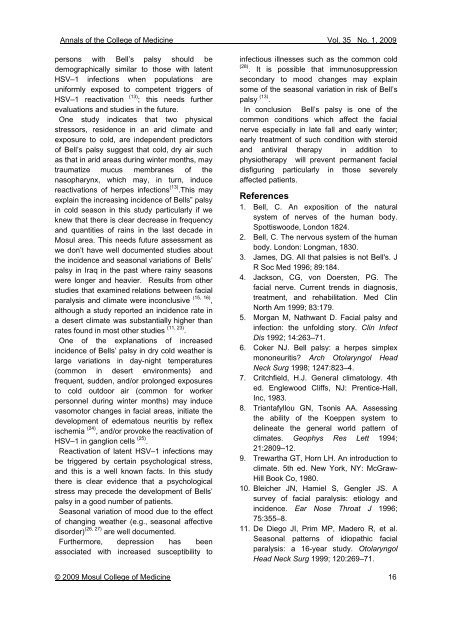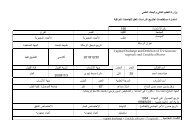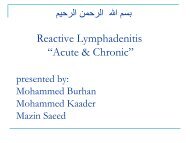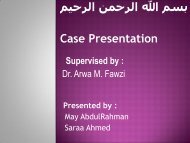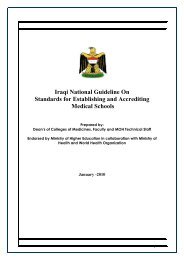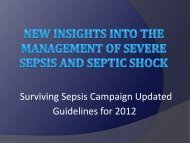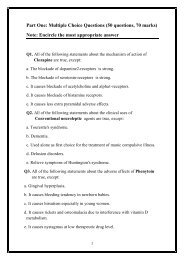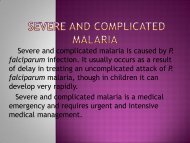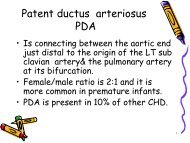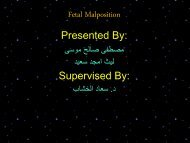Volume 35 June 2009 Number 1 - University of Mosul
Volume 35 June 2009 Number 1 - University of Mosul
Volume 35 June 2009 Number 1 - University of Mosul
Create successful ePaper yourself
Turn your PDF publications into a flip-book with our unique Google optimized e-Paper software.
Annals <strong>of</strong> the College <strong>of</strong> Medicine Vol. <strong>35</strong> No. 1, <strong>2009</strong><br />
persons with Bell’s palsy should be<br />
demographically similar to those with latent<br />
HSV–1 infections when populations are<br />
uniformly exposed to competent triggers <strong>of</strong><br />
HSV–1 reactivation (13) ; this needs further<br />
evaluations and studies in the future.<br />
One study indicates that two physical<br />
stressors, residence in an arid climate and<br />
exposure to cold, are independent predictors<br />
<strong>of</strong> Bell’s palsy suggest that cold, dry air such<br />
as that in arid areas during winter months, may<br />
traumatize mucus membranes <strong>of</strong> the<br />
nasopharynx, which may, in turn, induce<br />
reactivations <strong>of</strong> herpes infections (13) .This may<br />
explain the increasing incidence <strong>of</strong> Bells” palsy<br />
in cold season in this study particularly if we<br />
knew that there is clear decrease in frequency<br />
and quantities <strong>of</strong> rains in the last decade in<br />
<strong>Mosul</strong> area. This needs future assessment as<br />
we don’t have well documented studies about<br />
the incidence and seasonal variations <strong>of</strong> Bells’<br />
palsy in Iraq in the past where rainy seasons<br />
were longer and heavier. Results from other<br />
studies that examined relations between facial<br />
paralysis and climate were inconclusive (15, 16) ,<br />
although a study reported an incidence rate in<br />
a desert climate was substantially higher than<br />
rates found in most other studies (11, 23) .<br />
One <strong>of</strong> the explanations <strong>of</strong> increased<br />
incidence <strong>of</strong> Bells’ palsy in dry cold weather is<br />
large variations in day-night temperatures<br />
(common in desert environments) and<br />
frequent, sudden, and/or prolonged exposures<br />
to cold outdoor air (common for worker<br />
personnel during winter months) may induce<br />
vasomotor changes in facial areas, initiate the<br />
development <strong>of</strong> edematous neuritis by reflex<br />
ischemia (24) , and/or provoke the reactivation <strong>of</strong><br />
HSV–1 in ganglion cells (25) .<br />
Reactivation <strong>of</strong> latent HSV–1 infections may<br />
be triggered by certain psychological stress,<br />
and this is a well known facts. In this study<br />
there is clear evidence that a psychological<br />
stress may precede the development <strong>of</strong> Bells’<br />
palsy in a good number <strong>of</strong> patients.<br />
Seasonal variation <strong>of</strong> mood due to the effect<br />
<strong>of</strong> changing weather (e.g., seasonal affective<br />
disorder) (26, 27) are well documented.<br />
Furthermore, depression has been<br />
associated with increased susceptibility to<br />
infectious illnesses such as the common cold<br />
(28) . It is possible that immunosuppression<br />
secondary to mood changes may explain<br />
some <strong>of</strong> the seasonal variation in risk <strong>of</strong> Bell’s<br />
palsy (13) .<br />
In conclusion Bell’s palsy is one <strong>of</strong> the<br />
common conditions which affect the facial<br />
nerve especially in late fall and early winter;<br />
early treatment <strong>of</strong> such condition with steroid<br />
and antiviral therapy in addition to<br />
physiotherapy will prevent permanent facial<br />
disfiguring particularly in those severely<br />
affected patients.<br />
References<br />
1. Bell, C. An exposition <strong>of</strong> the natural<br />
system <strong>of</strong> nerves <strong>of</strong> the human body.<br />
Spottiswoode, London 1824.<br />
2. Bell, C. The nervous system <strong>of</strong> the human<br />
body. London: Longman, 1830.<br />
3. James, DG. All that palsies is not Bell's. J<br />
R Soc Med 1996; 89:184.<br />
4. Jackson, CG, von Doersten, PG. The<br />
facial nerve. Current trends in diagnosis,<br />
treatment, and rehabilitation. Med Clin<br />
North Am 1999; 83:179.<br />
5. Morgan M, Nathwant D. Facial palsy and<br />
infection: the unfolding story. Clin Infect<br />
Dis 1992; 14:263–71.<br />
6. Coker NJ. Bell palsy: a herpes simplex<br />
mononeuritis? Arch Otolaryngol Head<br />
Neck Surg 1998; 1247:823–4.<br />
7. Critchfield, H.J. General climatology. 4th<br />
ed. Englewood Cliffs, NJ: Prentice-Hall,<br />
Inc, 1983.<br />
8. Triantafyllou GN, Tsonis AA. Assessing<br />
the ability <strong>of</strong> the Koeppen system to<br />
delineate the general world pattern <strong>of</strong><br />
climates. Geophys Res Lett 1994;<br />
21:2809–12.<br />
9. Trewartha GT, Horn LH. An introduction to<br />
climate. 5th ed. New York, NY: McGraw-<br />
Hill Book Co, 1980.<br />
10. Bleicher JN, Hamiel S, Gengler JS. A<br />
survey <strong>of</strong> facial paralysis: etiology and<br />
incidence. Ear Nose Throat J 1996;<br />
75:<strong>35</strong>5–8.<br />
11. De Diego JI, Prim MP, Madero R, et al.<br />
Seasonal patterns <strong>of</strong> idiopathic facial<br />
paralysis: a 16-year study. Otolaryngol<br />
Head Neck Surg 1999; 120:269–71.<br />
© <strong>2009</strong> <strong>Mosul</strong> College <strong>of</strong> Medicine 16


